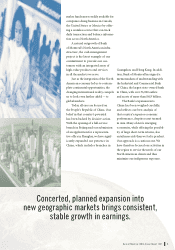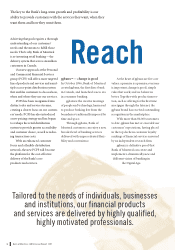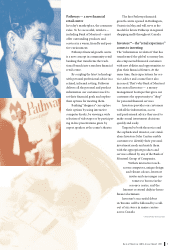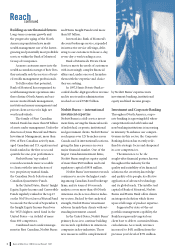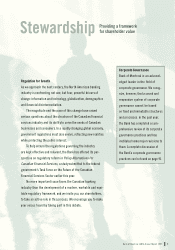Bank of Montreal 1997 Annual Report Download - page 17
Download and view the complete annual report
Please find page 17 of the 1997 Bank of Montreal annual report below. You can navigate through the pages in the report by either clicking on the pages listed below, or by using the keyword search tool below to find specific information within the annual report.
Bank of Montreal 180th Annual Report 1997 15
Fully diluted earnings per share in 1997
reached $4.62, representing an 11.9% improvement
over $4.13 in 1996, due in large part to strong busi-
ness volume growth, cash collections on impaired
loans, and earnings from equities and bonds of
lesser developed countries, partly offset by con-
tinued investment in the future and a $75 million
charge for accelerated depreciation and credit pro-
cess efficiency improvement. We also continued to
benefit from our state-of-the-art management of
credit risk. Our excellent results reflect the benefit
of being diversified as economic conditions change.
Our strong performance this year includes
an increase to our general reserves. Without this
$200 million charge, EPS would have been $5.05.
And, of course, we continued to invest in future
growth which, again, is consistent with our finan
-
cial philosophy of earning, growing and investing
all at the same time. Over the last few years, we
have invested more than $2 billion in strategic
spending to ensure future earnings growth
in light
of the rapidly
changing competitive environment.
To date, the primary investments made in Nesbitt
Burns,
Harris Bank in the U.S., and Grupo
Financiero
Bancomer, Mexico’s leading financial
institution, have contributed to total increased
earnings from these areas of $100 million.
Profitability, measured by return on common
shareholders’ equity (ROE), reached 17.1% in
1997, marking the eighth consecutive year that
our ROE has exceeded 14%. At the same time
net income growth was 11.7%, down from the
previous year’s 18.4%.
ROE, which increased from 17.0% the previ-
ous year, would have been 18.7% without the
$200 million charge to increase our general provi-
sion. Our performance was driven by our strategic
diversification of income sources by line of busi-
ness, geographic market and customer segment.
(Details: Pages 22 and 23.)
Revenue Growth: Best in Nine Years
Led by Investment and Corporate Banking and
Global Treasury Group, both of which benefited
from robust capital markets, revenue growth in
1997 reached 15.1%, up from 9.9% in 1996.
Our best revenue growth numbers in nine
years can also be attributed to strong asset growth
in our Canadian and U.S. retail banks, which
have benefited from the expanding North American
economy, and cash collections and earnings on
bonds and equities of lesser developed countries
in Global Treasury. (Details: Page 24.)
Productivity: Investing for Future Growth
Our expense to revenue ratio increased by
100 basis points to 64.4% in 1997, reflecting rev-
enue growth of 15.1% and expense growth
of 16.8%. Productivity improvements were offset
by investments to ensure future growth, includ-
ing the critical development of electronic delivery
channels; the increased cost of variable com-
pensation; accelerated depreciation related to
technology changes; and costs to improve the
efficiency of our credit process. (Details: Page 28.)
Operating Group Review: Introducing EFS and GTG
We added a fifth principal line of business or
operating group, Electronic Financial Services
(EFS), as well as creating Global Treasury Group
(GTG) in 1997.
EFS takes responsibility for mbanx, our
one-year-old virtual banking division; cash man-
agement services; telephone banking and other
electronic delivery channels; credit card opera-
tions; Institutional Trust and Custody; our elec-
tronic commerce services subsidiary, Cebra Inc.;
and our strategic alliance with Grupo Financiero
Bancomer. Due to essential strategic investment
in the development of electronic delivery chan-
nels, EFS net income declined by 7.4% in 1997.
GTG combines our financing and treasury
lines of business, and also takes responsibility for
relationship management for Non-Bank Financial
Institutions and Governments and International
Financial Institutions. Driven by capital markets,
GTG demonstrated brisk income growth in 1997
of 26.9%.
Strong capital market forces in the low
interest rate environment drove the 33.9% growth
rate for Investment and Corporate Banking.
Volume growth, considerably offset by the cost
of integrating the 54 Household community banks
acquired in 1996, was largely responsible for income
growth of 21.4% at Harris Regional Banking in 1997.
In Personal and Commercial Financial
Services the benefits of business volume growth
and strong expense control were offset by lower
margins and migration of customers to mbanx,
resulting in a net income decline of 1.4%.
In a year when net income increased across
most operating groups and income sources out-
side Canada topped 50% of our total income,
we take this as further evidence of how well the
Bank is adapting to the global marketplace, and
how well our strategies are working for North
America. (Details: Page 30.)


